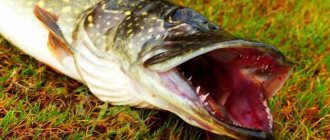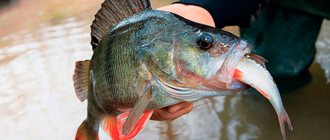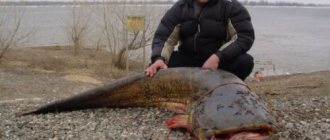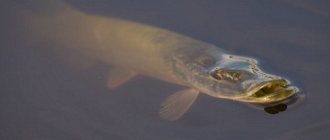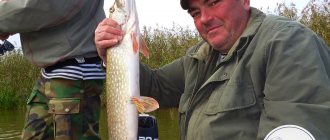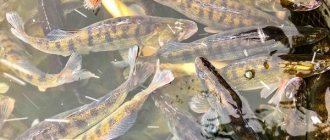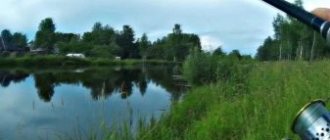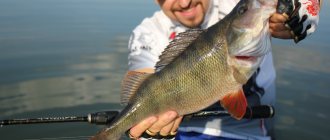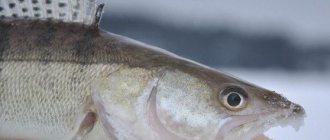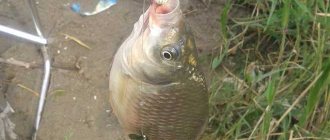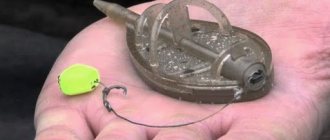For this type of pike fishing, several fishing methods are used, some of which are used by poachers. These are all kinds of traps and other predatory methods of extraction. The following types of gear are considered amateur:
- summer and winter types of vents;
- mugs;
- donka;
- bottle;
- float
Among all, 3 types of gear are most often used, so it is necessary to consider them in more detail.
Fishing with a float
Making such tackle is quite simple; it does not require the purchase of expensive rods or reels. We take the simplest and most accessible forest. The simplest hooks and rods are used. The rod must be equipped with guides and reel clamps.
One of the popular methods of catching pike is a float bait fishing rod. No matter how disdainfully “advanced” spinning anglers speak about such fishing, it is quite interesting and catchy. And the size of the trophies is often such that lovers of jigs and twitching could never even dream of.
What to catch
We catch pike on girders
A sliding option is used, which has a number of undeniable advantages:
- Allows you to make long casts.
- The pike takes the bait more confidently without feeling any resistance.
Varieties of pike donkey designs can be safely divided into three main groups, on the basis of which each fisherman can bring the tackle to perfection, in his own understanding, and mount it according to his own individual requirements.
The first group includes classic installation, when a weight weighing from 50 to 200 grams is attached to a fishing line or cord up to 20 meters long and with a diameter of 0.3-0.5 mm. Loops are made on the main thread for installation through the swivel of a steel leash.
Its length varies from 20 to 40 cm and the leash is equipped with a double or triple hook. The donka is thrown from the shore with baited bait into the water and tied to nearby vegetation or a specially prepared peg.
The entire structure, to indicate a bite, is equipped with a bell (read more about how to properly place live bait on a hook).
Equipment of the second type involves the use of an elastic band in the gap between the load and the main thread. Having the ability to stretch 5-7 times, freely increasing its length and returning to its original position, this improvement makes it possible, having cast the tackle, to subsequently re-equip it with live bait without completely removing it from the water.
To pull it ashore and lower it back into the forest using the elasticity of an elastic band, in common parlance a model. This type of donkey is called fishing with an elastic band.
The third group includes bottom rigs mounted on a fishing rod with a spinning reel, most often on a conventional spinning rod with a semi-fast action. The equipment is supplied with one live bait, and installation is similar to the previous types: a sinker and a strong metal leash with a hook.
The rod is installed on a stand on the shore of a reservoir and, according to the fisherman’s preference, is equipped with a bite alarm. Fishermen nicknamed this design a snooker.
And here's what you need to know: Grayling fishing in the spring - in Siberia, gear, in May
You can make a donk for catching pike quite quickly, having prepared the necessary materials in advance. Purchase a skein of strong fishing line or braided cord, it is advisable to buy with a reserve. A hundred-meter coil is ideal. The diameter, as mentioned above, is from 0.3 mm. Pike on a hook are aggressive and strong, and the roughness of the tackle usually doesn’t bother them much; safety margin is a priority.
Reels can be made from plywood or hard and rigid plastic. If you plan to make a donk with an elastic band, then additionally buy a model with a thickness of 0.8-1 mm.
On a twenty-meter main cord, it is enough to mount an elastic band 3-4 meters long. The main cord is tied into a loop with an elastic band.
At the other end of the elastic band, a carabiner is mounted to secure the load. The weight used is lead and preferably one with flat sides.
A pyramid or any flat figure is quite what is needed for a stable position of the load at the bottom.
Important! Weights with rounded shapes are susceptible to the influence of currents and are not recommended for installation for bottom gear.
Casting a donkey is an important success factor. The elastic band only means throwing the load to the required distance. With this option of equipping the donks, the leashes are installed after casting. In other cases, casting is carried out with live bait suspended on a hook.
You anchor 10-15 meters from the entrance to the hole and cast into the hole. Casting should be done against the current - the live bait will look more natural. Bites often occur on dumps, but this is where snags can also occur. You can make the first casts without live bait - just with a sinker in order to find out how much the fall is snagged.
Probably the best places for catching pike in this way are the confluence of two rivers, far from the shores of the island, as well as noticeable changes in depth.
Advantages and disadvantages of live bait fishing
The main advantage of fishing with live bait is a good bite at almost any time of the year. The only exception is the period of melting ice and snow, when the water in lakes and rivers becomes cloudy. But, if you do not take into account April and early May, pike constantly react to this bait.
The second advantage: this is a fairly budget fishing option. Special wobblers or spinners are not needed. Live bait can be attached to a double or triple hook, and you can catch it without any financial costs, using a bread ball. This option is suitable for beginners who are not very knowledgeable about artificial baits.
The third advantage is ease of use . There is no need to go into the theory of using flavors, special pastes or pheromones. Fresh and brightly colored fry attract fish without any additional manipulation if the water is not polluted.
The disadvantages include the following:
- Time required to catch live bait.
- The difficulties of maintaining the freshness of such bait, which are described below.
Spinning fishing with live bait: fishing rod equipment and fishing methods
Through the gills.
Fishing with live bait is one of the alternative options during pike lack of bite. A passive and lethargic pike that refuses to take spinning baits is highly likely to bite on a live and naturalistic fish that moves naturally and has the necessary real smell.
Therefore, fishing with live bait is one of the highly promising methods of fishing for striped predators. Mugs and girders are not as convenient as fishing with a spinning rod using live bait.
This method of fishing does not require a boat. The casting of the rig will be much better if you use a spinning rod instead of hand casting.
How to fish with live bait on a spinning rod so that fishing is as productive as possible? And how to choose the right equipment?
And here's what you need to know: Fishing for crucian carp: with a nod, jig, spinning rod, hooks, fishing line
Place and time of spinning fishing with live bait
Throughout the open water season, pike exhibit a variety of activities. The highest activity of pike is observed in the spring before and after spawning, as well as in the fall from the end of August until the freeze-up.
Therefore, during these periods, fishing for pike with live bait will be the most promising. And during periods of inactivity of pike, particularly in summer, fishing with live bait is considered the most promising way to catch it.
Moreover, a toothy predator can take bait at any time of the day - therefore, it is better to install live bait spinning tackle for a long period of time - in this case, the probability of capture will be higher.
The striped predator prefers calm weather, both clear and with light drizzle. During full moons and periods of fluctuations in atmospheric pressure, the likelihood of catching a pike is significantly reduced.
The prospects of a fishing spot largely depend on the time of year - the colder it is, the deeper it is necessary to look for a striped predator. Both on the river and in a standing reservoir, the probability of capture significantly depends on the bottom topography and the presence of vegetation. The most promising places are:
- sand spits and rifts, possibly with a small amount of underwater vegetation;
- bays behind sand spits with moderate currents;
- places near snags or fallen trees;
- edges and other depth differences;
- fairway holes;
- places near coastal vegetation, water lilies, reeds;
- next to the bridge pilings.
In such places, very often the predator stands in ambush and waits for the fry to swim past. If fishing is carried out in a large water area, for example, near large fields of water lilies, then in the absence of bites it is advisable to transfer bait to different promising places. The same tactics are acceptable when fishing near the walls of reeds.
I hurried to hook - fed the fish, catching pike and perch with live bait
The basis of any fishing is the natural instincts of predators. Spinning fishing is no exception. In spring, summer, and autumn you can catch predatory fish using live bait. This applies to pike, perch, pike perch, catfish, and burbot.
Fishing with live bait knows many ways: with bottom tackle, a float rod, with girders, and trolling. I decided to talk about how fishing with a spinning rod works, so I won’t touch on other methods of fishing. Although they also deserve attention.
I often ask myself the question: “Why is this method not widespread among spinning fishing enthusiasts?” Probably because for many, spinning is more of a sporting component, an opportunity to outwit a predator with artificial bait.
An important role is also played by the fact that those who engage in spinning no longer return to the old methods, because this is a completely different fishing. Predators are offered artificial baits of such colors and shapes that the fish wants to taste them, it reacts to them actively, and sees them from afar. And such food as inconspicuous live bait is well known; it must be brought under her nose in order to interest her.
If you don’t sit on the shore with bottom gear, but try to actively look for fish, systematically fish for points where, for example, pike or pike-perch can presumably be found, then this type of fishing will not seem boring. And good physical activity will be ensured.
Advantages and disadvantages
For live bait fishing, the spinning rod is equipped with float tackle. The advantages of fishing with a spinning rod include the fact that it is much more convenient to cast bait and make long casts. It also shows good results when playing.
The disadvantage of this method is that when hooking between the reel and the float, the fishing line sags, and the fish is not hooked very sharply. An unsharp notch can prevent a toothy pike from breaking through the mouth and it will wave its tail at you.
Zywiec
I catch live bait or fry at the fishing spot; perch or pike prefer fish from their native reservoir. And there are no problems with transporting such a delicate “good” as live bait.
Fry are, in a way, a litmus test for a pond. If there are no small fish, then the predator, most likely, will not come to this place, there is no food, he has nothing to do there.
Zywiec
If you prepare live bait in advance, you can store it at home in settled tap water. When settling, chlorine leaves the water. Here are the basic rules for storing live bait:
- Avoid changes in water temperature. Do not move it from warm to cold water and back.
- You must transport live bait to the fishing spot very carefully; you cannot shake it too much.
- Do not allow the water in which it is located to heat up. In the summer, while you are driving in the car, you need to cover the container with fish from the sun, perhaps placing bottles of cold water nearby.
- When you arrive, be sure to add clean water to the container.
It’s not enough to get or buy live bait; you also need to preserve it. It will be difficult to preserve live bait in a metal bucket or plastic bag with water; these containers become very hot in the sun. Having caught live bait, it is better to put it in a fish tank and a pond, in the shade of trees. So, the fish will last a long time.
Small crucian carp or minnows, bleak, rudd, small sailors, in general, any little thing are used as live bait. Pike and large perch will peck on live bait measuring 10-12 centimeters, small perch are caught on fry. Preserving fry for perch fishing is even more difficult than preserving live bait for pike.
You can catch live bait with a light fishing rod or a special net for fry, it is called a small fish and is sold in the store.
The bait should be cast in such a way that it enters the water at an angle of about 30 degrees, and does not splash with all its might. After all, the fisherman’s task is to damage the live bait with hooks as little as possible. The same goal, caring for live bait, is pursued when hooking it. They cling mainly to the dorsal fin.
The bait should be accessible, the live fish should not lie on the bottom, hide in vegetation or, if it is a roach or bleak, rise to the upper layers of the reservoir. It is necessary to balance the live bait and the float.
Pike
Catching large pike with live bait requires the presence of a spinning rod, which can be used to make long casts of 20-30 meters.
Rod equipment
It’s good if there is an inertia-free reel on the rod, but this is not critical, you can choose any reel, as long as it is powerful. The fishing line will need about 100 meters. The fishing line should be strong, 0.3-0.4 mm, a braided cord will also work.
Here is one example of equipment: a cork or foam float is mounted on the main line, followed by a load of lead “olives”. The weight of the sinker is 8-10 grams. Next, make a swivel and attach a leash with a hook to it.
Three in one
Many people prefer a metal leash, which, from their point of view, is less susceptible to being bitten by the sharp teeth of a pike. But there is also an opinion that pike do not take live bait on a metal leash so readily.
The length of the leash does not matter. But still, think about the fact that instead of a leash, the toothy fish can bite through the main fishing line, so it is not advisable to use a very short one. For such equipment, only single hooks with a long shank are used.
The tip on the hooks should be bent towards the fore-end. It is not at all necessary to fish with a large hook, the main thing is that it is well sharpened. I often had small pike swallow a hook that was too big for them, and at the same time a 2-kilogram pike was caught on a small hook.
When biting, the pike does not completely swallow the hook, and double or triple hooks give about 50% of the hooks. So, from my point of view, a single hook is more reliable. But they also catch on tees, and more than one. See how summer fishing for big baitfish happens:
Fishing tactics
When attacking, the pike grabs the bait crosswise, then it goes into cover and swallows it whole. Therefore, the fishing tactic is to give slack to the fishing line and allow the pike to calmly move away. You need to wait for the second tightening of the line, pause for a moment, and then start picking up the slack.
The main thing is not to rush and wait for the pike to swallow the bait along with the hook. Excessive fuss and nervousness when playing will cause great harm. Wait calmly for a pause. But if the pike does not stop moving, having moved 4-5 meters away, hook it, there is nothing to wait for.
Pike take crushed live bait better.
Summer pike fishing begins in the morning, while it is still cool. But the summer heat has a bad effect on it; it stays near the bottom and feeds poorly.
Perch
If fishing is carried out on an unfamiliar body of water in the summer, then it is with a spinning rod that you can find it faster. In spring, perch is hungry and more active, in summer it is well-fed. But in spring and summer it reacts well to live bait. It has been noticed that perch can bite on live bait faster than on a dung worm or porridge. Of course, the size of the live bait should match the size of the perch.
Fishing with live bait is carried out with discreet gear, and the hook is well hidden so as not to scare away the fish. In the place where you catch perch, it will be difficult to catch fry, since the predator itself will hunt them. The fry are also carefully caught by the fin or upper lip. The most important thing is not to damage it, otherwise it will be a dead fish and not live bait.
Perch using live bait
When choosing gear, you must take into account that the perch that lives in the river is stronger than those living in the lake. In a river, fish resist the current.
In summer you should look for perch in the depths; only during the feeding period can you see them in the shallows.
This video shows summer fishing, catching perch:
Having grabbed the bait, the perch begins to move in a circle with short stops. It will swim 2-3 meters with live bait and stop. It floats on, stops again.
Since perch is still lower in its habitat than pike in the food chain, if a perch is caught, there is no pike nearby. Otherwise, this toothy predator herself would have declared a hunt for him. At the same time, in such reservoirs where there are a lot of perch, the pike will be reluctant to take live bait, because it is already well-fed.
Folk sign: At the end of fishing, you need to thank the pond, collect all the garbage and things, otherwise there will be no more bite in this place!
kakulov.ru
Features of seasonal fishing
The best time for pike fishing is late autumn and early spring. At this time, the fish actively feeds and attacks all types of bait.
Pike fishing in autumn
A good catch with normal gear will be available even to a beginner during this period. This time is very important for her: she eats actively, storing fat for the winter. At this time, the main habitats of the predator are deep barrels, whirlpools, edges, and riverbeds.
Trying to cast bait into shallow water is generally not recommended. In this case, time will be wasted in the absence of bites.
The boundaries of landfills and deep holes are the initial places for fishing.
Fishing in summer
Spring and early summer are one of the favorite seasons of all lovers of exciting and productive fishing. The pike eats off after the deep winter and spawning.
But its activity drops significantly in July. The water becomes very hot and the fish become lethargic and inactive.
And here's what you need to know: Catching crucian carp in the summer from a boat using a float rod using pearl barley and a worm
The reserves help her cope with hunger, so fishermen can prepare their gear for a month and a half. Sometimes it is possible to get it to attack live bait with small cuts on the body.
But already in August the activity of pike increases; you can catch it in different places of the river or lake. At this time, she can go out into the current in pursuit of fry.
In summer it is more difficult to catch pike, so the trophy will be more desirable.
In conclusion, some advice from experienced anglers.
Catching pike with live bait using a float rod from the shore
The article will talk about catching pike with a simple summer float rod, fishing in open water from the shore. You will learn how to equip a float rod for catching pike with live bait. The tactics and technique of fishing for this predatory fish with the above-mentioned gear are considered. Fishing for pike with live bait using a float rod is also called “fishing for pike with a float,” i.e. in essence it is the same process. So, let's go.
Advantages of fishing for pike with a float rod compared to fishing with a spinning rod
It happens that the characteristics of a certain body of water do not always make it possible to use spinning fishing. Imagine a lake overgrown with grass, where among the aquatic vegetation (reeds, duckweed, water lilies, etc.) there are only small cleared windows. Even if the reservoir is not overgrown, along the shore there are often overgrown places with windows in which a predator is hiding and waiting for prey.
How to use a spinner in such overgrown places when fishing with a spinning rod? How to fish with spinning baits in small pools on the river? Of course, you can try to throw a bait, for example, a silicone one - a vibrotail or a twister. But in order to provoke a predator to attack, most often you need to “play” with artificial bait. Usually, stationary artificial bait is of little interest to fish.
However, high-quality play with bait may be impossible due to the short length of the pool or window among the algae. Having thrown the bait, after a short retrieve, you have to immediately pull this vibrating tail, twister or wobbler out of the water, and you’ll even catch a lump of green mud. That is, in such conditions, the pike often does not have time to grab the bait.
In general, it is inconvenient to use spinning fishing with artificial bait in the above-mentioned places, which is one of the reasons why they catch pike from the shore with live bait using a float rod. When fishing for “lazy” pike and during times of weak bite, a float rod can also become the most effective tackle.
The next reason why people prefer fishing for pike with a float is the ease of fishing. You just need to attach a live bait, cast it and wait for a bite. No special knowledge in fishing tactics is required; the live bait itself will provoke the predator to bite. And also, catching pike with live bait using a float tackle can be considered less expensive than using a spinning rod with artificial bait.
Unlike fishing for pike on a float, spinning fishing requires a reel for long casts, the cost of which is significantly higher than the reels used in float fishing rods (we compare cheap models). You also need to buy various artificial baits. The most catchy baits, as a rule, are not cheap. The difference in the price of the rods is also noticeable. For example, jig spinning rods are much more expensive than float rods (again, we compare inexpensive models).
Don’t think that I’m against spinning rods or anything like that; I like to fish with a spinning rod, as well as with a float rod. Spinning fishing is very interesting, but it is not always possible for a novice fisherman to immediately buy a spinning rod and all the bells and whistles for it. Therefore, usually a novice angler’s first tackle is an inexpensive float rod. Actually, while there is no spinning rod, you can catch pike with a float rod. Well, now you know when fishing for pikes with a float is most relevant. Go ahead.
Equipment of a float rod for catching pike with live bait
As I already wrote in previous articles, depending on the fishing conditions, there are “float fishing rods with running equipment” and “dead tackle”. In order not to repeat myself, I will leave links to articles where this is discussed in detail:
How to assemble a float rod
How to fish with a float rod without a reel - blind tackle
How to fish with a float rod and reel - a float rod with a running rig
The design of the fishing rod for pike fishing is the same as described in the above articles. When equipping a float rod, you should take into account the characteristics and habits of the fish, in this case pike. Our predator has sharp teeth that can bite through the fishing line, the fish itself is large, when fishing it strongly resists, and sometimes even jumps out of the water to free itself.
It is imperative to take into account the weight of the fish, i.e. what is the maximum weight of pike expected. I understand that you want the more, the better. What if there are simply no such “monsters” in the fishing area? The usual weight of a trophy is up to 2-3 kg. Of course, you can set yourself up to catch larger “crocodiles”, but their numbers are smaller and there may not be any at the fishing site. And I will also repeat that the article is about equipping a cheap float rod, which is unlikely to support fish weighing more than 3 kg.
I will share an incident from my life. Once I caught pike with live bait using a float rod. In my hands I had the most ordinary budget 5-meter fishing rod with rings and a simple reel. A very large fish pecked at a small baitfish, 8 cm long. I can’t tell its weight because I couldn’t pull this fish out. I didn’t have time to lower the fishing line from the reel, the fishing line tightened sharply, the fishing rod bent into an arc and, grunting... the third knee from the top broke. I immediately grabbed the fishing line, hoping to pull the fish out by it, but I was too late, the fishing line was already broken.
What's this conversation about? If you use budget fishing rods, then you won’t be able to pull out very large specimens, which means you shouldn’t use thick fishing line or braid in case an 8-kilogram pike bites.
Based on the above, I suggest the following equipment:
Rod 4-5 meters. I fished with 6-meter ones, but they seemed uncomfortable to me; it’s hard to fish in windy conditions. You can fish with 3-meter float rods, but I don’t fish because I have a spinning rod of the same length. Therefore, when I can use fishing rods with running equipment and a length of 3 m, I pick up a spinning rod.
Monoline from 0.22 to 0.28 mm, optimal size - 0.26 mm, maximum - 0.35 mm. When catching fish up to 3 kg with blind tackle, this is enough, even with a reserve. Of course, you also need to take into account the quality of the fishing line. I pulled out kilogram pikes on good quality monofilament with a diameter of 0.14 mm.
Float and sinker. It is important to follow the rule - the float should not sink under the weight of the sinker and live bait. You shouldn’t let the baitfish drown it, but let it drag it around the pond. For example, if a float for live bait with a carrying capacity of 30 grams, then put a weight weighing 25 grams. If the float has a lifting capacity of 6 g, use a 4 g weight. I hope the meaning is clear, that is, the weight of the sinker is slightly less than the norm indicated on the float. You choose the type of float (sliding or regular) according to the situation or based on personal preferences (read the articles mentioned above about floats).
It is better to use a leash made of material that the pike cannot bite through. But it should be remembered that on a metalized leash, live bait moves worse and dies faster than on a monofilament line. Therefore, using a leash made of monofilament, more bites are observed. However, as mentioned above, there is a risk that it will be bitten by a predator when it swallows the hook deeper. As you gain experience, decide for yourself whether your tackle needs a metallic leash or not. To begin with, I recommend using metallic “cable” leashes 20-40 cm long, equipped with a swivel and clasp.
I use hooks for pike No. 8.5-11 according to the Russian classification (see table Classification and numbering of fishing hooks). I prefer treble hooks, but double and single hooks can be used.
Small roach, perch, rotan, bleak, gudgeon and other small fish can be used as live bait. Pike weighing up to 2 kg bite on live bait measuring 8-12 cm. They can even take a fry only 5-6 cm long, but usually perch is caught on such fry. For larger pike, the live bait should be larger - about 18 cm or more. They catch live bait on the spot or bring it with them. Therefore, take care of a container for storing live bait so that they swim there alive.
There are different ways to hook live bait. The most common one is hooked onto the back. It is important not to damage the spine of the baitfish during baiting, otherwise the baitfish will become inactive and quickly die. Try not to pierce the area below the dark colored back with the sting. You need to cast and pull out live bait smoothly, without jerking, so the bait will be more intact.
A little about the tactics of catching pike on a float
If the live bait is no longer alive, it’s okay, you can try playing with it - teasing the pike. This is done simply - smooth movements of the live bait up/down. You just have to pull the live bait closer to the shore, at a distance equal to the length of the rod. By the way, pike can also bite on a dead fish, even without playing. Therefore, when the bite is bad or there is none at all, you can fish with dead bait and wait longer for the bite - 40-50 minutes.
The specified pauses, time, and how long you need to wait may be different for you. Suddenly you come across an active feeding of pike, then 5-10 minutes will be enough to check whether there is a predator in this place or not. By the way, to find out the pike biting activity, see the article - Pike biting calendar - when the pike bites. Of course, the data is approximate, but you will know in which months to expect the best bite.
A very important point is hooking. When fishing for pike with live bait, you cannot immediately hook it after the float dives for the first time. First, the pike grabs the bait crosswise, moves a little to the side, turns it around and swallows it. Only after this does it leave the place where the prey was caught. In the eyes of the fisherman it looks like this. The float has sunk, now you need to create conditions for the line to flow as freely as possible, for example, when the fishing rod has a spinning reel, open the bow.
When fishing with blind tackle, if you feel that there is not enough free line, you can at this moment extend your hand forward (in the direction of the float movement). So, having grabbed the bait, the pike swims away to about two or three meters and stops. Now you need to wait for a more powerful pull, i.e. wait until the predator swallows the bait. You have to wait about one minute, or even two.
After waiting a pause, we slowly pull the line until it makes soft contact with the fish. Next, pay attention to the tip of the rod - if it trembles slightly, it means you were in a hurry, the bait is still being swallowed. If the rod is bent into an arc, we hook and pull out the fish. Waiting for this pause is the most nerve-wracking part. The main thing is not to rush, otherwise, instead of the long-awaited trophy, you will pull out the chewed bait directly from the predator’s mouth, and then you will scold yourself for rushing.
There are times when the fish reels in the line and doesn’t stop. Most likely, a large predator gobbled up the small bait fish entirely, and didn’t even notice. But even in these cases, before hooking, it is better not to rush and wait a pause. When fishing for fish up to 2-3 kg, you don’t have to stand on ceremony; after hooking, immediately drag the pike to the shore. This haste is necessary to reduce the likelihood of a bite when using monofilament as a leash, and also to prevent the pike from getting tangled in the line behind snags and bushes when fishing in such places.
When fishing, it would be a good idea to have with you a device (yawner, extractor) for removing tees from the mouth of a pike. The hook may end up deep in the predator’s mouth; unhooking it with your fingers is not very convenient, and it’s easy to get hurt on sharp teeth. For every firefighter, you can take a landing net. Also, don’t forget to take a supply of tees, leaders and sinkers. That's all, I wish you good fishing!
Published: April 19, 2021, 22:03
- Tags:
- live bait fishing
- float rod
- pike
zamryb.ru
A little about choosing live bait for pike
Let’s not talk for long about the fact that it is preferable to catch pike using the “food supply” that it feeds on, that is, using exactly those types of fish that pike eats in its usual habitat, but there are other equally interesting “live baits”, their We will also touch on this in a further description.
Types of live bait and their features:
Roach
There is nothing better for river pike fishing than roach. Its biggest advantage is its accessibility, since you can catch it in almost every river. You can add rudd to the roach and the result will be, plus or minus, the same.
Gudgeon
Excellent live bait, both for still waters and for currents. The body structure of the gudgeon allows the fish to easily swallow it, even if it is a small bee.
Perch
An excellent live bait for cold seasons, not exactly what this article is about, but it was not entirely right to ignore this type of bait. Its spines perfectly camouflage hooks; pikes are reluctant to part with the perch. In summer, unfortunately, perch quickly dies in the cage, so it is not entirely suitable for this period.
Bleak
Normal, runaway baitfish. Just like perch is not able to survive for a long time and must be baited with caution, since there is a high probability of damaging the fish and thereby “killing” the whole trick of fishing with live bait.
crucian carp
The best representative for fishing in reservoirs, lakes or quarries. Easy to transport and store.
Rotan
"Emigrant" from the Far East. Great for pike, but only in October and November. A recent immigrant from the Far East has become very popular with pike. It is well suited for fishing in autumn, October and November, as it becomes active at this time.
Up
How to catch pike with live bait in summer and winter
Pike can be caught with live bait throughout the year with equal success, changing only the hunting equipment. Small fish, the natural diet of the toothed predator and the fisherman’s competent presentation of bait in almost any conditions bring success. The annual fishing cycle is divided into two periods: open and closed water.
The summer season is characterized by limited hunting in water bodies due to the heavy overgrowth of water areas with aquatic vegetation. It is in these thickets that the fish feed and rest. Under such conditions, they are caught point-by-point, in windows of vegetation. Tackle for catching pike with a float and stationary girders are used most effectively. Mugs for still waters are also an acceptable fishing option.
Autumn fishing is the most widespread in terms of the use of various equipment. Bottom tackle in all its forms, mugs, girders, cradle - everything can be safely used. Pike feed most actively in autumn. The range of its hunting grounds is significantly increasing, and water areas are being cleared of dense thickets, which only contributes to the comfort of fishing in various ways. Catching large pike in the fall with live bait is targeted, especially with the approach of cold weather and the first frosts.
Winter radically changes the approach to fishing. Freezing up makes fishing sessions more comfortable, because now you can get to all promising places and reliably install equipment, without being distracted by solving the problems of large waves, wind and thickets in the reservoir. Winter stakes with flags become the main weapon for pike throughout the entire closed water season.
Spring time is the breeding season. Pike, tired both after winter and after the mating season, begins the first wave of zhora. It feeds mainly near the bottom in open spaces. These features of spring behavior provide grounds for the use of bottom gear. Catching pike with an elastic band along the edges of reservoirs has a greater chance of success than a pike fishing rod with float rigs.
Float live bait
Fishing with live bait from the shore involves the use of float gear and, to a greater extent, in a fly-fishing style. For this purpose, a powerful telescopic or plug-type fishing rod with a test weight of over forty grams and a length of six or seven meters is selected. For greater functionality of the gear, expressed in reducing its total weight and maneuverability when casting and landing fish, the use of a reel is not recommended.
The main cord is attached directly to the quivertype through a rubber shock absorber made from a model, 1–1.5 mm thick and 10–15 cm long. Monofilament with a diameter of at least 0.3 mm is used as the main cord, with the possibility of spontaneous immersion. The use of a rubber shock absorber and monofilament is due to the extreme loads when fishing for pike on short lines, and these materials are guaranteed to compensate for overloads and preserve the catch. Floats are made of polystyrene foam, with short antennas and a barrel-shaped body. As a rule, 20–25 grams is the optimal weight of the accessory, allowing you to clearly control the live bait and signal a bite.
The sinker is placed in the form of a sliding olive, based on the weight of the float used. The live bait fishing rod is equipped with a double hook for installing fish through the gills; the effectiveness and advantages of this installation method were described above. Equipment for catching trophy pike with live bait cannot do without the use of a metal leash. For catching medium-sized grass, leashes made from fluorocarbon fishing line are suitable. Leashes are used with a length of at least 15 cm and are attached to the main cord through a swivel.
Pike is caught with a fishing rod in coastal water thickets. The equipment is installed at a promising point, releasing the fish 30–40 cm from the bottom and waiting for the predator to attack for ten to fifteen minutes. If there is no bite, they change their location, moving further along the coastline and looking for the next suitable point. The pike bite is sharp and aggressive, with the float being pulled under the water or far to the side from the attack site.
The fish are in no hurry to hook, allowing the predator to swallow the bait pressed down with its teeth. Visually, this looks like a stop of the float and its slight trembling. Any movement after a short stop requires a thorough hooking and further careful landing of the fish. Near the shore, it is mandatory to use a landing net to raise fish. Pike is caught on a float mainly in the summer, when the fish stands in the thickets and is inactive in migrating through the reservoir.
Fishing in summer with a zherlitsa
Another variation on the theme of live bait equipment is presented in the form of a girder.
The specifics of use are similar to the use of circles, but here the fishing line is stored on special reels attached to a bush or tree.
After installing the girder, the fishing line is secured in the split of the reel so that in case of a bite it would come off the reel without any problems and the pike would swallow the bait without feeling any danger.
summer bait for pike

